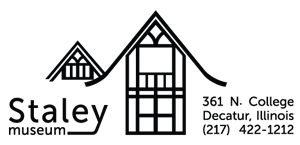The Staley Museum in Decatur, Illinois
The Staley Museum opened its doors to the public during the summer of 2015. We are excited be a full-fledged member of our community. Here you will find updates and news about the museum and exciting events going on.
The Staley Museum and this web site are both works in progress. We encourage visitors to continue to check back with us and see how we are progressing. We would also like to encourage visitors to the site to share any stories or information they may have regarding Staley history.
Photos, documents, articles and memorabilia are all welcome and appreciated. Anyone wishing to make a contribution to the Staley museum may contact us through via the Artifact Donation Form found on this site. Also, for anyone in our area who wishes to be a Volunteer at the museum and offer their time and/or expertise, please go to the Volunteer Form and fill out your information so that we may contact you personally. We invite you to Contact Us.
Visit the Staley Museum
The Staley Museum is open year-round
Tuesday – Saturday: 1:00 – 4:00 pm
Last Sunday of the month (March – November): 1:00 – 4:00 pm.
Admission
Adults: $5
Seniors: $3
Child (18 and under): $1
Location
361 N. College Street
Decatur, IL
The Staley Story
A.E. Staley was a big man with big dreams and had the determination to make those dreams a reality. Although he did not arrive on the scene until the 1900’s, his impact of Decatur was such that he is counted as one of the founding fathers. The largeness of his dreams and of his civic minded generosity has contributed in major ways to the city we know today.
It was A.E.’s pioneering vision in the area of soy beans, both the cultivation and processing, that gave Decatur the name “Soy Bean Capitol of the World.”
In the period of one decade, 1920-1930, A.E. Staley made significant contributions to the community of Decatur, being the driving force behind the creation of Lake Decatur, the Staley viaduct, the Staley Office Building, and the formation of the Decatur Staleys football club, later to become the Chicago Bears.
The story of A.E. Staley is one in which the city of Decatur has the right to feel great pride. It is a story which forms a major part in the industrial and agricultural history of central Illinois. We look forward to sharing that pride and history as we work toward the opening of the Staley Museum.
The Staley Office Building: Inaugurated in April, 1930
Also known as “The Castle in the Cornfields”
Photo courtesy of the Hieronymus Mueller Museum

The Staley Office Building: Inaugurated in April, 1930
Also known as “The Castle in the Cornfields”
Photo courtesy of the Hieronymus Mueller Museum








0 CommentsComment on Facebook